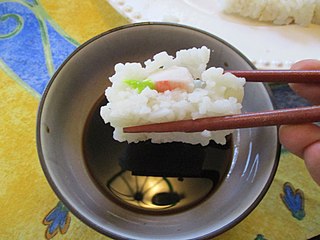 W
WA dip or dipping sauce is a common condiment for many types of food. Dips are used to add flavor or texture to a food, such as pita bread, dumplings, crackers, cut-up raw vegetables, fruits, seafood, cubed pieces of meat and cheese, potato chips, tortilla chips, falafel, and sometimes even whole sandwiches in the case of au jus. Unlike other sauces, instead of applying the sauce to the food, the food is typically placed or dipped into the sauce.
 W
WArtichoke dip is a dip that uses artichoke as a primary ingredient. Some versions are served chunky, while others are puréed and have a smooth texture. It may be served as an hors d'oeuvre along with crackers or chips for dipping. Commercially prepared artichoke dips are produced for consumer purchase. It has been described as "one of the most popular appetizer menu items of all time".
 W
WBaba ghanoush, also spelled baba ganoush or baba ghanouj, is a Levantine appetizer of Lebanese origin consisting of mashed cooked eggplant, olive oil, lemon juice, various seasonings, and sometimes tahini. It may be served with onions, tomatoes, or other vegetables. The eggplant is traditionally baked or broiled over an open flame before peeling, so that the pulp is soft and has a smoky taste. It is a typical meze ('starter') of the regional cuisine, often served as a side to a main meal and as a dip for pita bread.
 W
WBagna càuda is a hot dish made from garlic and anchovies, originating in Piedmont, Italy during the 16th century. The dish is served and consumed in a manner similar to fondue, sometimes as an appetizer, with raw or cooked vegetables typically used to dip into it.
 W
WBean dip is a type of dipping sauce made using beans or refried beans as a primary ingredient. It is typically served with tortilla chips, and can also be served with other foods such as crackers and crudités. Various types of beans are used, and fresh-cooked, canned or flaked beans can be used. Various additional ingredients are used in its preparation, such as onion, garlic, chili peppers and spices, and it is sometimes garnished with some ingredients. Bean dip can be served cold, at room temperature, or hot. Bean dip is sometimes used as an ingredient in the preparation of other dishes such as burritos and quesadillas.
 W
WBigilla is a traditional Maltese dish, made of mashed beans, olive oil, salt and red pepper. It is usually served as a dip. Tic beans, known in Malta as "ful ta' Ġirba", are used. These are similar to but smaller than broad beans, with a darker and harder skin.
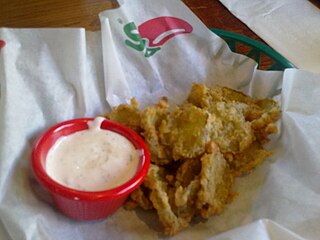 W
WBlue cheese dressing is a popular side sauce, salad dressing and dip in the United States. It is usually made of some combination of blue cheese, mayonnaise, and buttermilk, sour cream or yogurt, milk, vinegar, onion powder, and garlic powder. There is a blue cheese vinaigrette that consists of salad oil, blue cheese, vinegar, and sometimes seasonings.
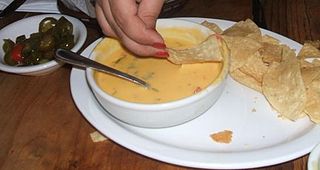 W
WChile con queso, sometimes called simply queso, is an appetizer or side dish of melted cheese, and chili peppers, typically served in Tex-Mex restaurants as a dip for tortilla chips.
 W
WChili oil is a condiment made from vegetable oil that has been infused with chili peppers. Different types of oil and hot peppers are used, and other components may also be included. It is commonly used in Chinese cuisine, East and Southeast Asia and elsewhere. Particularly popular in Sichuan cuisine, Hunan cuisine, and Shaanxi cuisine it is used as an ingredient in cooked dishes as well as a condiment. It is sometimes used as a dip for meat and dim sum. It is also employed in the Korean Chinese noodle soup dish jjamppong.
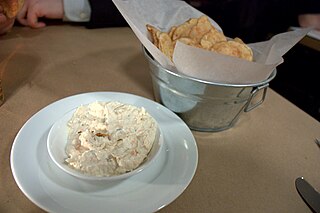 W
WChips and dip are a dish consisting of chips or crisps served with dips. Chips used include potato chips, tortilla chips, corn chips, bean chips, vegetable chips, pita chips, plantain chips and others. Crackers are also sometimes used, as are crudités, which are whole or sliced raw vegetables. Various types of dips are used to accompany various types of chips.
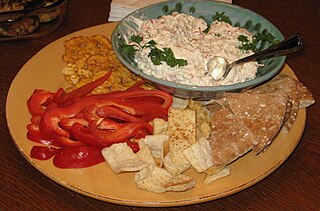 W
WClam dip is a dipping sauce and condiment prepared with clams, sour cream or cream cheese, and seasonings as primary ingredients. Various additional ingredients can be used. It is usually served chilled, although it is sometimes served hot or at room temperature. It is used as a dip for potato chips, crackers, bread, and crudités. Commercial varieties of clam dip are mass-produced by some companies and marketed to consumers in grocery stores and supermarkets.
 W
WCoconut jam is a jam made from a base of coconut milk, eggs and sugar. It is popular in Southeast Asia, mainly in Brunei, Indonesia, Malaysia, the Philippines, Singapore and Thailand.
 W
WCrab dip, sometimes referred to as Maryland crab dip, is a thick, creamy dip that is typically prepared from cream cheese and lump crab meat. Other primary ingredients such as mayonnaise may be used. Various types of crab preparations, species and superfamilies are used, as are a variety of added ingredients. It is typically served hot, although cold versions also exist. Hot versions are typically baked or broiled. It is sometimes served as an appetizer. Accompaniments may include crackers and various breads. Some U.S. restaurants offer crab dip, commercially produced varieties exist, and some stadiums offer it as a part of their concessions.
 W
WDabu-dabu is a type of hot and spicy condiment commonly found in Manado cuisine of North Sulawesi, Indonesia. Dabu-dabu chopped red chili peppers, bird's eye chili, shallots, red and green tomatoes, and a pinch of salt and sugar. All of the chopped and diced spices are mixed with fresh calamansi juice or locally known as lemon cui or jeruk kesturi; sometimes calamansi is replaced by kaffir lime or lemon juice. The chili pepper and citrus juice give it a fresh sour and spicy flavour.
 W
WDuqqa, du'ah, do'a, or dukkah is an Egyptian and Middle Eastern condiment consisting of a mixture of herbs, nuts, and spices. It is typically used as a dip with bread or fresh vegetables for an hors d'œuvre. Pre-made versions of duqqa can be bought in the spice markets of Cairo, where they are sold in paper cones, with the simplest version being crushed mint, salt, and pepper. The packaged variety that is found in markets is composed of parched wheat flour mixed with cumin and caraway. In the Hejaz region it has been part of the regional cuisine for decades.
 W
WMany cuisines feature eggplant salads and appetizers.
 W
WFrench onion dip or California dip is an American dip typically made with a base of sour cream and flavored with minced onion, and usually served with potato chips as chips and dip. It is also served with snack crackers and crudités. It is not French cuisine; it is called "French" because it is made with dehydrated French onion soup mix.
 W
WGuacamole (Spanish: [ wakaˈmole] ; is an avocado-based dip, spread, or salad first developed in Mexico. In addition to its use in modern Mexican cuisine, it has become part of international and American cuisine as a dip, condiment and salad ingredient.
 W
WHummus is a Middle Eastern dip, spread, or savory dish made from cooked, mashed chickpeas blended with tahini, lemon juice, and garlic. The standard garnish in the Middle East includes olive oil, a few whole chickpeas, parsley, and paprika.
 W
WKiwi onion dip is a type of dipping sauce eaten in New Zealand. Often referred to as 'kiwi dip', 'onion dip' or 'original kiwi dip', it consists of a packet of powdered onion soup stirred into a can of reduced cream, which is then left to refrigerate and thicken. Served alongside potato chips, crackers, or chopped vegetables, the dip is a popular dish at parties, barbeques, and other social occasions. A small amount of vinegar or lemon juice can be added to the dip for flavour.
 W
WMuhammara or mhammara is a hot pepper dip originally from Aleppo, Syria. It is popular in the Levantine cuisine. In Turkey, muhammara is referred to as acuka.
 W
WNachos are a Mexican regional dish from northern Mexico that consists of heated tortilla chips or totopos covered with melted cheese, often served as a snack or appetizer. More elaborate versions of the dish include other ingredients, and may be substantial enough to serve as a main dish. Ignacio "El Nacho" Anaya created the dish in 1940. The original nachos consisted of fried corn tortilla chips covered with melted cheese and sliced jalapeño peppers.
 W
WNam chim or nam jim is Thai for "dipping sauce". It can refer to a wide variety of dipping sauces in Thai cuisine, with many of them a combination of salty, sweet, spicy and sour.
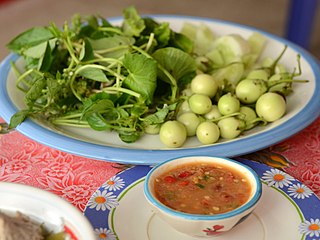 W
WNam phrik is a type of Thai spicy chili sauce typical of Thai cuisine. Usual ingredients for nam phrik type sauces are fresh or dry chilies, garlic, shallots, lime juice and often some kind of fish or shrimp paste. In the traditional way of preparing these sauces, the ingredients are pounded together using a mortar and pestle, with either salt or fish sauce added to taste.
 W
WNam phrik long ruea is a Thailand side-dish, a kind of fried nam phrik that is normally eaten with vegetables.
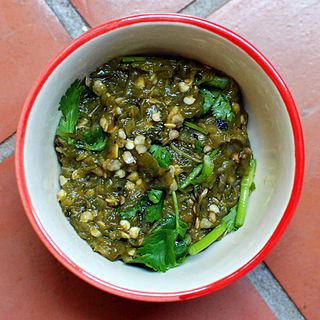 W
WNam Phrik Num is a kind of “Nam phrik”. It is commonly served in a small bowl or saucer placed by the main dish as a condiment or a dip, mostly for uncooked or boiled vegetables, sticky rice, or pork crackling.
 W
WNam phrik phao is a type of Thai spicy chili sauce known as nam phrik, one of the chilli pastes used in Thai cuisine. It contains chiles, fermented shrimp, shallots, tamarind, galangal, and ginger.
 W
WRanch dressing is an American salad dressing usually made from buttermilk, salt, garlic, onion, mustard, herbs, and spices mixed into a sauce based on mayonnaise or another oil emulsion. Sour cream and yogurt are sometimes used in addition to, or as a substitute for, buttermilk and mayonnaise.
 W
WSalsa is a variety of sauces used as condiments for tacos and other Mexican and Mexican-American foods, and as dips for tortilla chips. They may be raw or cooked, and are generally served at room temperature.
 W
WSambal is a chili sauce or paste, typically made from a mixture of a variety of chili peppers with secondary ingredients such as shrimp paste, garlic, ginger, shallot, scallion, palm sugar, and lime juice. Sambal is an Indonesian loan-word of Javanese origin (sambel). It originated from the culinary traditions of Indonesia, and is also an integral part of the cuisines of Malaysia, Sri Lanka, Brunei and Singapore. It has also spread through overseas Indonesian populations to the Netherlands and Suriname.
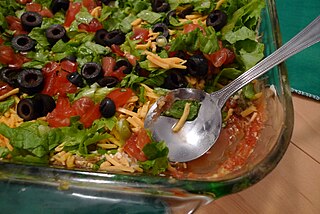 W
WA seven-layer dip is an American appetizer based on ingredients typical of Tex-Mex cuisine. The first widely published recipe called it Tex-Mex Dip without reference to any layers. The dish was popular in Texas for some time before the recipe first appeared in print.
 W
WSpinach dip is a dip that uses the vegetable spinach as a primary ingredient. Frozen spinach is often used in its preparation. Slow cookers may be used to prepare the dip, or there may be no cooking involved. Additional primary ingredients include mayonnaise, cream cheese, sour cream and cheese. Examples of accompaniments to spinach dip include bread, crackers and chips.
 W
WTaramasalata or taramosalata is a Greek meze made from tarama, the salted and cured roe of the cod, carp, or grey mullet (bottarga) mixed with olive oil, lemon juice, and a starchy base of bread or potatoes, or sometimes almonds. Variants may include garlic, spring onions, or peppers, or vinegar instead of lemon juice. While not traditionally Greek, smoked, rather than cured, cod's roe is more widely available in some places, and often used. Bottarga is usually much more expensive than cod's roe.
 W
WTexas caviar is a salad of black-eyed peas lightly pickled in a vinaigrette-style dressing, often eaten as a dip accompaniment to tortilla chips. Texas caviar was created in the U.S. state of Texas around 1940 by Helen Corbitt, a native New Yorker who later became director of food service for the Zodiac Room at Neiman Marcus in Dallas, Texas. She first served the dish on New Year's Eve at the Houston Country Club. When she later served it at the Driskill Hotel in Austin, Texas, it was given its name, "Texas caviar," as a humorous comparison to true caviar, an expensive hors d'oeuvre of salt-cured fish roe. It has also been called cowboy caviar.
 W
WTzatziki, cacık, or tarator is a dip, soup, or sauce found in the cuisines of Southeast Europe and the Middle East. It is made of salted strained yogurt or diluted yogurt mixed with cucumbers, garlic, salt, olive oil, sometimes with vinegar or lemon juice, and herbs such as dill, mint, parsley and thyme. It is generally served as a cold appetizer (mezze) or a side dish.